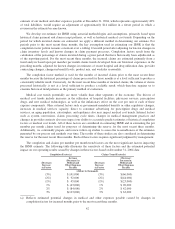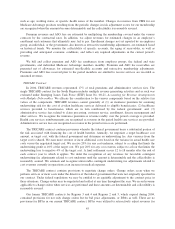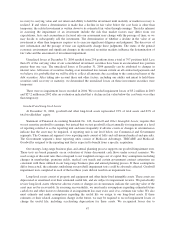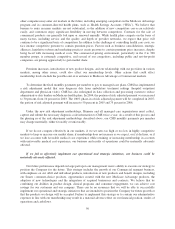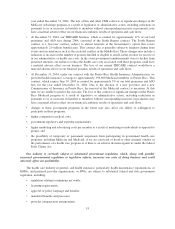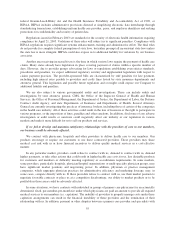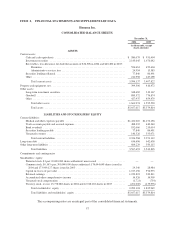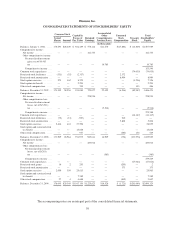Humana 2004 Annual Report Download - page 60
Download and view the complete annual report
Please find page 60 of the 2004 Humana annual report below. You can navigate through the pages in the report by either clicking on the pages listed below, or by using the keyword search tool below to find specific information within the annual report.other companies may enter our markets in the future, including emerging competitors in the Medicare Advantage
program and in consumer-directed health plans, such as Health Savings Accounts (“HSA”). We believe that
barriers to entry in many markets are not substantial, so the addition of new competitors can occur relatively
easily, and customers enjoy significant flexibility in moving between competitors. Contracts for the sale of
commercial products are generally bid upon or renewed annually. While health plans compete on the basis of
many factors, including service and the quality and depth of provider networks, we expect that price will
continue to be a significant basis of competition. In addition to the challenge of controlling health care costs, we
face intense competitive pressure to contain premium prices. Factors such as business consolidations, strategic
alliances, legislative reform and marketing practices create pressure to contain premium price increases, despite
being faced with increasing medical costs. The commercial pricing environment, particularly in the 2 to 300
member groups, is extremely competitive, and several of our competitors, including public and not-for-profit
companies, are pricing aggressively to gain market share.
Premium increases, introduction of new product designs, and our relationship with our providers in various
markets, among other issues, could also affect our membership levels. Other actions that could affect
membership levels include the possible exit of or entrance to Medicare Advantage or Commercial markets.
To determine the fixed monthly payments per member to pay to managed care plans, CMS has implemented
a risk adjustment model that uses diagnosis data from ambulatory treatment settings (hospital outpatient
department and physician visits). CMS has also redesigned its data collection and processing system to reduce
administrative data burden on Medicare health plans. In 2004, the portion of risk adjusted payment was increased
to 30 percent, from 10 percent in 2003. The 100% phase-in of risk adjusted payment will be completed in 2007;
the portion of risk adjusted payment will increase to 50 percent in 2005 and 75 percent in 2006.
Under the new risk adjustment methodology, Humana and all managed care organizations must collect,
capture and submit the necessary diagnosis code information to CMS twice a year. As a result of this process and
the phasing in of the risk adjustment methodology described above, our CMS monthly payments per member
may change materially, either favorably or unfavorably.
If we do not compete effectively in our markets, if we set rates too high or too low in highly competitive
markets to keep or increase our market share, if membership does not increase as we expect, or if it declines, or if
we lose accounts with favorable medical cost experience while retaining or increasing membership in accounts
with unfavorable medical cost experience, our business and results of operations could be materially adversely
affected.
If we fail to effectively implement our operational and strategic initiatives, our business could be
materially adversely affected.
Our future performance depends in large part upon our management team’s ability to execute our strategy to
position the Company for the future. This strategy includes the growth of our Commercial segment business,
with emphasis on our ASO and individual products, introduction of new products and benefit designs, including
our Smart, consumer-choice products, opportunities created with the new Medicare Advantage products, the
adoption of new technologies and the integration of acquired businesses and contracts. We believe that by
combining our abilities in product design, clinical programs and consumer engagement, we can achieve cost
savings for our customers and our company. There can be no assurance that we will be able to successfully
implement our operational and strategic initiatives that are intended to position the Company for future growth or
that the products we design will be accepted. Failure to implement this strategy or to contain our administrative
expenses in line with our membership may result in a material adverse effect on our financial position, results of
operations and cash flows.
50




